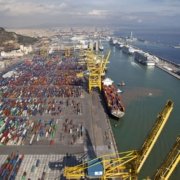Clean fuels, electrification, water and hydrogen – How are ports handling energy transitions?

Written by: Lidia Slawinska, Consultant
Over the past few months, a lot of our articles have focused on sustainable solutions in intermodal transport – whether they were connected to port operations, maritime transport or port-railway solutions. Focusing on alternative and clean energy solutions is vital, in particular in light of this summer’s heat waves, floods, and other weather phenomena which are gaining in strength every year. The European Union has recently renewed its dedication to the Green Deal, committing itself to substantially lowering the carbon emissions of the EU by an extremely ambitious 55% by 2030, and to eliminate net emissions by 2050. Taken together, all of this suggests that sustainability needs to take centre stage in all of our transport operations if we are to meet those goals and help protect our Blue planet.
The Escola is committed to promoting sustainable transport and incorporates its principles to all of its courses – and this is why this month we wanted to touch upon one of those. The upcoming course on Energy Transitions in Ports will take place in October of this year, and will aim to raise awareness and provide information to the management and technical staff of port authorities that are part of the MEDPorts Association on specific aspects related to energy transition in ports. However, when we talk about said “energy transition”, what do we mean?
The current climate
According to some scientific estimates (2019: The Atlantic), it is likely that sea levels will rise considerably by the end of this century, therewith putting 14% of the earth’s major ports susceptible to flooding and erosion. This is near-universally explained by the rising global temperatures, which contribute to a faster melting of the ice caps.
Maritime transport currently is responsible for about 80% of freight transported globally (by volume). As such, nearly 3% of CO2 emissions are sent into the atmosphere alone – a percentage that has increased by more than 30% in the last two decades. This characteristic of the current “golden age of oil” has had a detrimental effect on our climate already. Continuing on this same trajectory will increase this number to nearly 17% of all global emissions by the middle of our century – therewith further hastening the rise of the sea levels.
All of this suggest that leading ports need to take action now and adapt their infrastructures to offset any threats that may arise from the rising sea.
Clean fuels
When thinking about the prospect of energy transition in ports, the fuel used by the visiting vessels is central. Ships – whether they are cruises or container-carriers – need to stay in the ports they visit – to load and unload, and to re-supply. This requires the ships to stay powered whilst these operations are taking place, and ports have had to design alternative electrical systems of On-Shore Power Supplies (OPS) to lower their emissions in-port. Many ships have already started to run on new alternative fuels that have considerably smaller carbon footprints – including LNG (Liquefied Natural Gas), hydrogen, ammonia and ethanol.
The vessels that operate within a port – the ones transporting the pilots or tugging the larger vessels entering the harbour – would also need to be modified. Some ports have already taken initiative such zero-emission crafts – one example being the Hydrotug boat under construction in the Port of Antwerp.
This transformation of the vessels, which also includes the capacity to be powered by the on-shore electrical or gas-powered systems, would need to be accelerated for the industry to become greener.
Electrification
As hinted in the previous section, electrification is a vital process in the energy transition of ports. Making sure that the modern ports have adequate electric facilities and technologies in place, be it through either OPS, electrified wharfs, or electric ferries or vessels that perform other port operations.
Energy production
Trying to make sure that the energy transition in ports is not a double-edged sword, which then puts increasing pressures on existing power infrastructures in their hinterlands (and therewith continue to leave a significant carbon footprint), ports also need to think about using their vicinities to generate their own power. Turning seawalls into energy producers, or having offshore wind turbines can significantly increase the Gigawatts that the ports will depend on – therewith limiting the strain on the traditional infrastructures. It is vital that ports transform their mindset and develop new technologies that can create electricity from solar power, marine power, or bioenergy. Ports will need to become electricity producers that depend on a multitude of sources to supply their operations, whilst making sure that they are doing so with limited or no emissions to comply with the emerging global regulations.
In fact, some estimates now say that by the middle of this century, industrial ports will have the capacities to generate ten times more than today. This data was presented in the DNV GL’s study on Ports: Green Gateways to Europe. The report also stated that the energy transition methods that many ports are either considering or already implementing could easily account for the increase in port activities – traffic has been consistently increasing as globalisation has driven the economies forward. In order for this to take place consistently, the report recommends 10 specific transitions that would need to take place:
- Electrification of port-related activities
- Fuel switch for maritime transport
- Electrification of industry
- Integration of offshore wind
- Energy system integration
- Hydrogen as a feedstock and energy vector
- Phase-out of fossil-fuelled power plants
- Carbon capture and storage
- New regulations
- A circular and bio-based economy
(Source: Offshore Energy)
Final thoughts
Transforming our current energy infrastructure has taken centre stage is both our political and social dimensions. The transport sector has also taken note, and many private and public entities have already taken (sometimes) drastic steps to try to lower the carbon footprint of transport. Ports, in particular, have taken note – knowing that they represent the connection between the sea and the land, and therefore need to lead in the sustainable revolution and guide both land, rail and sea transport operators on the path towards decarbonisation.
Automation and innovative technologies already exist that can help ports become energy-efficient. With new laws and guidelines already in place, including the Paris Climate Agreement, the European Green Deal, and the latest EU 2030 Climate and Energy Framework, the path ahead for ports is doubtlessly difficult and winding, but righteous. Smart Ports and Green Ports are now becoming synonymous with the Ports of Tomorrow. The journey forward is green, and to survive, ports need to make sure that they on it.
Sources:









